Text

Christmas Night
There is an ancient legend that on Christmas night pets acquire the gift of speech and comment among themselves on the merits and shortcomings of their caregivers - us humans.
Bizarre and far-fetched as it may seem, this story certainly has the merit of granting, at a time widely celebrated by our culture, special attention to these beings: companions in life and work, lenders of labor and commodity for our livelihood.
Granting them the privilege of being able to express themselves verbally is perhaps a way of bringing them closer to us, an albeit momentary concession that makes them worthy of attention by enhancing their role.
Animals have souls, the word itself (“anima” is the Latin word for “soul”!) and the fact that, unlike plants, they move say so. Theirs is not an individual soul, but a group soul that oversees the behavior of the entire species.
They do not act at random (as, on the contrary, we humans may do): their only intent is the survival of the individual and their own species. Consequently, they always behave in the most appropriate, best-performing and effective way for this to happen.
The legend tells how animals, on holy night, should be looked after with special care, for example by providing them with good food and fresh water or straw to stretch out on. But it is also told how deleterious it is for us custodians, even on pain of death, to try to listen to their talk.
Allow me to make a proposal, for the approaching Christmas night: do not fabulously concede the word to the animal world, but instead learn, we from them, to be quiet. And to listen.
To listen to the darkness studded with stars, or even veiled by fog, to the fresh air we inhale, to the beating of our heart, to our breath, to our deepest intimacy, the one we are used to hiding or ignoring, or of which we are afraid - so much so that we prefer suffering to the emptiness we seem to face if we take care of it.
Listening instead of expressing, seeing instead of imagining, living instead of remembering, giving instead of demanding. All this requires courage. If still, and silent, we begin to see it... well then this can perhaps be called Christmas.
La notte di Natale
Narra un'antica leggenda che la notte di Natale gli animali domestici acquistino il dono della parola e commentino tra di loro pregi e mancanze di chi li accudisce - noi umani.
Per quanto bizzarra e inverosimile ci possa sembrare, questa storia ha certamente il pregio di concedere, in un momento ampiamente celebrato dalla nostra cultura, un'attenzione particolare a questi esseri: compagni di vita e di lavoro, prestatori d'opera e di materia prima per la nostra sussistenza.
Concedere loro il privilegio di potersi esprimere verbalmente è forse un modo di avvicinarli a noi, una concessione seppur momentanea che li rende degni di attenzione esaltandone il ruolo.
Gli animali hanno un'anima, lo dicono la parola stessa ed il fatto che, a differenza delle piante, si muovano. La loro non è un'anima individuale, ma un'anima di gruppo che sovrintende il comportamento dell'intera specie.
Non agiscono a caso (come, al contrario, possiamo fare noi): il loro unico intento è la sopravvivenza del singolo e della propria specie. Di conseguenza si comportano sempre nel modo più adeguato, più performante ed efficace affinché ciò avvenga.
Nella leggenda si racconta di come gli animali, nella notte santa, vadano accuditi con particolare attenzione, ad esempio mettendo loro a disposizione buon cibo ed acqua fresca o paglia per distendersi. Ma si narra anche di quanto sia deleterio per noi custodi, addirittura pena la morte, cercare di ascoltare i loro discorsi.
Mi permetto di fare una proposta, per la notte di Natale che si sta avvicinando: non favoleggiare concedendo la parola al mondo animale, ma al contrario imparare, noi da loro, a stare zitti. E ascoltare.
Ascoltare il buio tempestato di stelle, o anche velato dalla nebbia, l'aria fresca che inaliamo, il battito del nostro cuore, il nostro respiro, la nostra più profonda intimità, quella che siamo abituati a nascondere o a ignorare, o della quale abbiamo paura - tanto da preferire la sofferenza al vuoto che ci sembra di dover affrontare se ce ne curiamo.
Ascoltare invece di esprimersi, vedere invece di immaginare, vivere invece di ricordare, dare invece di pretendere. Tutto questo richiede coraggio. Se immobili, e muti, cominciamo a vederlo... ecco, questo forse si può chiamare Natale.
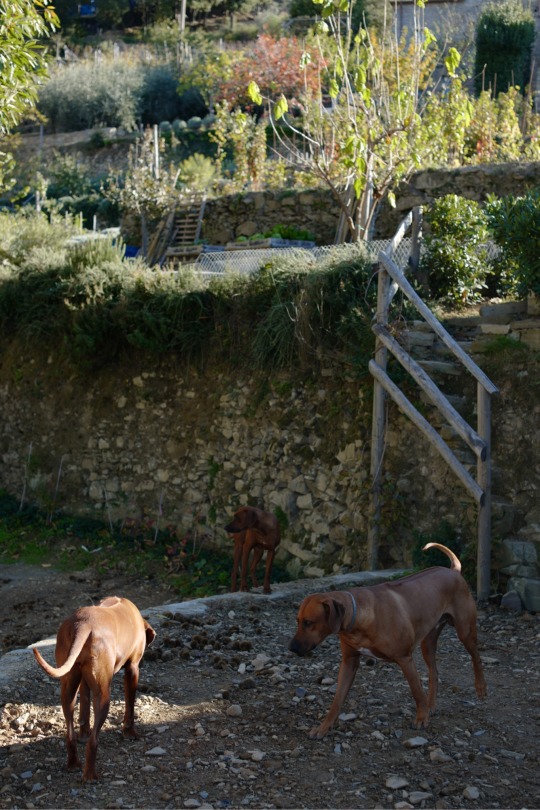

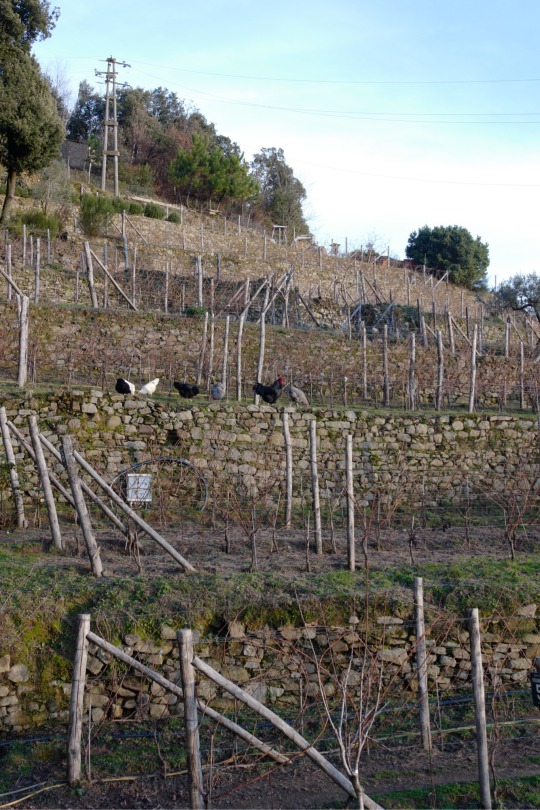

5 notes
·
View notes
Text
A heart-pounding craft
This is it: the last bunch of grapes is nabbed by the de-stemmer. Once the journey of the grapes is over, the journey of the wine begins.
This fleeting moment is the "rien ne va plus" of the wine-growing year, the work in the field, the harvest and the move to the winery: the wine's ultimate home. Ah, what a sigh of relief!
The end of a journey made of a thousand unknowns one after another, a thousand decisions to be made, day after day.
The winemaker's trade is a heart-stopping one. Harvesting is a birth that occurs, precisely, in the ninth month of pregnancy. If managed naturally, until the very last moment one does not know when it will occur.
Once filled, the boxes of grapes at Stella di Lemmen go from arm to arm and finally down the mountain: they rendezvous where the rack begins, are loaded and have a nice ride with a sea view, not without a few jolts and a few extra heart palpitations for the driver because of the weight and speed of the convoy on the steepest sections of monorail, almost as if they were on a roller coaster.
Up and down, up and down. Each journey ends with the heartening sight of the Litoranea road and the final comfort due to the slowing of the end of the ride. Saved, once again - we load the Ape and off with the transport to the cellar.
In the de-stemmer, the disappearance of the bunches follows at a rapid pace and each evening the day's grapes already rest in their tank, the cradle of the must.
The succession of seasons, weather patterns and the attention lavished on the vineyard, as well as the land that hosts it, turn to the final gathering, its florilegium: the wine.
He will express his past, the summary of the last vintage.
"In vino veritas," said the Latins. Wine does not lie, and it should help us not to lie. That is why we like it, why it intrigues us: because truth, for all of us, is vital, is sacred.
What to say? Thank you all guys, it was great once again. Thank you for your participation, your generosity, the effort, the synergy, the moment of life spent together, the tension as well as the laughter shared.
Bravo to all of us, from the oldest to the youngest. Thank you and...cheers!
I forgot: now, Konstantin, you take care of it! And the heartbreak continues...
Un mestiere al cardiopalma
Ci siamo: anche l’ultimo grappolo viene acciuffato dalla diraspatrice. Finito il viaggio dell’uva, inizia quello del vino.
Questo istante fuggente è il "rien ne va plus" dell’anno viticolo, del lavoro in campo, della vendemmia e del trasferimento in cantina: la casa del vino. Ah, che sospiro di sollievo!
La fine di un percorso fatto di mille incognite una dopo l'altra, mille decisioni da prendere, giorno dopo giorno.
Il mestiere del vignaiolo è un mestiere al cardiopalma. La vendemmia un parto che si verifica, appunto, al nono mese di gravidanza. Se gestito in modo naturale, fino all’ultimo non si sa quando avverrà.
Una volta riempite, le cassette di uva a Stella di Lemmen passano da braccia a braccia e infine scendono dalla montagna: si danno appuntamento dove inizia la cremagliera, vengono caricate e si fanno un bel viaggio con vista mare, non senza qualche scossone e qualche palpito del cuore in più per il conducente, per via del peso e della velocità del convoglio nei tratti di monorotaia più ripidi, quasi fossimo su un ottovolante.
Su e giù, su e giù. Ogni viaggio termina con la rincuorante vista della Litoranea ed il conforto finale dovuto al rallentamento del fine corsa. Salvi, ancora una volta - si carica l’Ape e via col trasporto in cantina.
Nella diraspatrice la sparizione dei grappoli si sussegue a ritmo veloce ed ogni sera le uve della giornata già riposano nella loro vasca, la culla del mosto.
Il susseguirsi delle stagioni, dell’andamento climatico e delle attenzioni elargite alla vigna, così come alla terra che la ospita, volgono all’adunata finale, il suo florilegio: il vino.
Lui ci restituirà il suo trascorso, il riassunto dell’ultima annata.
“In vino veritas” dicevano i latini. Il vino non mente, e ci dovrebbe aiutare a non mentire. Per questo ci piace, ci intriga: perché la verità, per tutti noi, è vitale, è sacra.
Che dire? Grazie a tutti ragazzi, è stato bello ancora una volta. Grazie della vostra partecipazione, della vostra generosità, della fatica, della sinergia, del momento di vita trascorso insieme, della tensione così come della risata condivise.
Bravi a tutti noi, dai più anziani ai più giovani. Grazie e...salute!
Dimenticavo: adesso, Konstantin, pensaci tu! E il cardiopalma continua...
#farm#biodynamicfarming#winery#cinqueterre#biodynamicwine#wineharvest#biodinamica#biologico#winelover
1 note
·
View note
Text

Summer morning
It's a blessing! Such a morning rarely happens. No one passes by on the trail, the guests are still asleep, it is Sunday, and therefore the crew didn't come to work: no motorcarts or brush cutters, no vociferating in the vineyards, all is silent at Stella di Lemmen.
All that can be heard is the song of the little birds and that of the roosters, which, freed from their night shelters, call out to each other from afar, competing to see who can sing best. They are joined by the tenuous hum of a few bumblebees on the lawn (they are the first to get to work) and the gentle rustle of olive tree branches around the house, moved by the breeze.
The sun has not yet emerged from behind the hill, and without its presence the silvery light offers a rare intimacy and heralds a glorious day. The sky screen lights up in anticipation.
The light rain two days ago has made the endless shades of green around us more intense: vines, trees, bushes - everything seems to quiver in the early morning light.
A few breaths of air sway the tops of the trees and the highest shoots of the vines: they look like arms that, raised, wave from afar. It is likely that later the wind will strengthen, but for now it is only a timid hint that gently envelops us in coolness and stillness and sends us back to breath, the foundation of our life.
The sea sheds its purple dress, that of farewell to darkness, and changes to cobalt, preparing to welcome the sun.
It appears motionless from here, but if you pay attention you can make out the succession of long waves driven by a last breath of the mistral. Soon it will become an expanse of glistening blue.
What enchantment is all this beauty, what joy, what wonder! An instant of magic that reflects our intimacy. Nature - thriving, vibrant, disarming - offers itself for what it is: an impassive, immovable, untouched mirror.
For beauty, peace, love and what some call "the kingdom of heaven" are all here, exclusively within us.
Mattina d'estate
È una benedizione una mattina così, capita di rado. Nessuno passa sul sentiero, gli ospiti dormono ancora, è domenica e di conseguenza i ragazzi non sono venuti al lavoro: niente motocariole o decespugliatori, né vociare nelle vigne, tutto tace a Stella di Lemmen.
Sì sente soltanto il canto degli uccellini e quello dei galli, che liberati dai loro ricoveri notturni si chiamano da lontano facendo la gara a chi canta meglio. Si aggiungono tenui il ronzio di qualche bombo sul prato (sono i primi a mettersi al lavoro) ed il fruscio dei rami degli ulivi intorno a casa, mossi dalla brezza.
Il sole non è ancora spuntato da dietro la montagna, e senza la sua presenza la luce argentea offre una rara intimità e annuncia una giornata gloriosa. Lo schermo del cielo si accende nell'attesa.
La leggera pioggia dell’altro ieri ha reso le infinite tonalità di verde che ci circondano più intense: vigne, alberi, cespugli, tutto sembra trepidare nella prima luce mattutina.
Qualche alito d'aria fa dondolare le cime degli alberi e i tralci più alti delle vigne: paiono braccia che, levate, salutano da lontano. È probabile che più tardi il vento si rafforzi, ma per ora è solo un timido accenno che ci avvolge delicatamente di frescura e di quiete e ci rimanda al respiro, il fondamento della nostra vita.
Il mare si spoglia del suo vestito violaceo, quello di addio alle tenebre, e si veste di cobalto preparandosi ad accogliere il sole.
Appare immobile da qui, ma se si presta attenzione si scorge il susseguirsi delle lunghe onde sospinte da un ultimo alito di maestrale. Presto diventerà una distesa di rilucente blu.
Che incanto tutta questa bellezza, che gioia, che meraviglia! Un istante di magia che riflette la nostra intimità. La natura - prospera, vivace, disarmante - si offre per quello che è: uno specchio impassibile, inamovibile, intatto.
Perché la bellezza, la pace, l'amore e quello che qualcuno chiama “il regno dei cieli” sono tutti qui, esclusivamente dentro di noi.

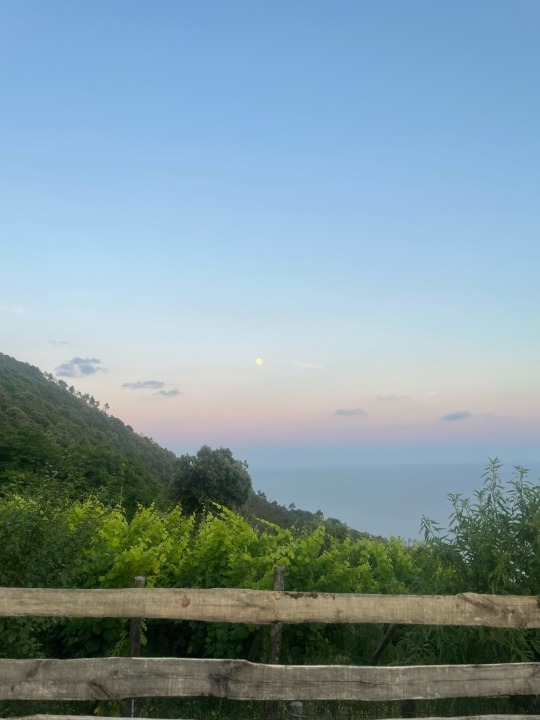
#biodynamicfarming#farm#sunrise#summer morning#biodinamica#aziendaagricolabiologica#aziendaagricolabiodinamica#nature#biodynamicwine#farming#biologico#cinqueterre#cinque terre
1 note
·
View note
Text

Hello lavender!
In a sea of lavender, I would like to take strokes of wonder.
(Fabrizio Caramagna)
Lavender is currently one of the undisputed stars here in Stella di Lemmen. It is in full bloom and offers its best in every sense of the word - beautiful, colorful, fragrant. It appears to us everywhere gently and discreetly, dressed in its various hues and shades: from white to pink, from lilac to purple to deep blue.
Pollinating insects adore it: bees in the lead, visiting it already early in the morning, but also bumblebees, staying until late in the evening! Those who approach a bush are immersed in a vibrant, unison buzzing...which is not at all dangerous. The insects are busy exclusively foraging and, if disturbed, simply change flower.
Lavender is a Mediterranean scrub bush that usually remains around a meter in diameter or so. On bare mountain slopes it reaches up to 1,400 meters above sea level, with smaller specimens that develop even more vivid colors.
It has about 30 species, some of them native to Italy such as Spica, Vera, Latifolia, Dentata and Stoechas. The latter, an elegant variety with showy insect wing-like bracts at the head of the flower, is the most fragrant and re-blooming of all.
All these species and many others are present on our farm, scattered everywhere and actively participating in the biodiversity and beauty of the entire agricultural organism; they are a even more exceptional presence as the plants are at ease in poor and stony soils and, once started, do not need a single drop of water except that which is bestowed by the sky!
Wherever they are found, with their hues and intense fragrance they bring joy, awe and serenity...until harvest time comes, usually in late July. We are almost there! The most suitable varieties will be stripped of their spiky inflorescences, which we will distill to extract the precious essence.
Already the ancient Egyptians employed lavender essential oil because of its antiseptic properties, while the Romans added it to bath water to perfume, but also to purify themselves and "wash" themselves of diseases - hence its name.
At Stella di Lemmen it will accompany us and comfort us throughout the winter: as a room fragrance, for a temple massage in case of headaches, in herbal teas and in the preparation of delicious Christmas cookies. It will also serve to ward off insects and protect our clothing in the closets as well as, at all times, bestow its unmistakable aroma upon us.
By transforming the light, lavender elaborates its healing, calming and relaxing power, which brings benefits in anxious states or nervous disorders, soothes the soul and conciliates sleep. Even its color says so: a true gift from heaven!
Ciao lavanda!
“In un mare di lavanda vorrei fare bracciate di meraviglia.”
(Fabrizio Caramagna)
La lavanda al momento è una delle indiscusse protagoniste qui a Stella di Lemmen. È nel pieno della fioritura ed offre il meglio di sé in tutti sensi - bella, colorata, profumata. Ci appare in ogni dove con gentilezza e discrezione, vestita delle sue diverse tinte e sfumature: dal bianco al rosa, dal lilla al viola fino al blu intenso.
Piace, - ah come piace! - agli insetti impollinatori: le api in testa, che la visitano già di prima mattina, ma anche i bombi, che rimangono fino a tarda sera! Chi si avvicina ad un cespuglio si immerge in un vibrante, unisono ronzio…per nulla pericoloso. Gli insetti sono occupati esclusivamente a bottinare e, se vengono disturbati, si limitano a cambiare fiore.
La lavanda è un cespuglio della macchia mediterranea che solitamente rimane intorno al metro di diametro o poco più. Sugli scarni declivi montani si spinge fino ai 1.400 metri di altitudine, con esemplari più piccoli che sviluppano colori ancora più vivaci.
Conta una trentina circa di specie, alcune delle quali originarie dell'Italia come la Spica, la Vera, la Latifolia, la Dentata e la Stoechas. Quest'ultima, elegante varietà dalle vistose brattee simili ad ali di insetto in capo al fiore, è la più profumata e rifiorente in assoluto.
Tutte queste specie e molte altre sono presenti nella nostra azienda, sparse in ogni dove e attivamente partecipi alla biodiversità e alla bellezza dell'intero organismo agricolo; ancor più eccezionale presenza in quanto le piante sono a loro agio anche in terreni poveri e sassosi e, una volta avviate, non necessitano di una sola goccia d'acqua se non quella elargita dal cielo!
Ovunque si trovino, con le loro tinte ed il loro profumo intenso apportano gioia, stupore e serenità...fin quando giunge l'epoca della raccolta, solitamente a fine luglio. Ci siamo quasi! Le varietà più adatte verranno private delle loro infiorescenze a spiga, che distilleremo per ricavarne la preziosa essenza.
Già gli antichi Egizi impiegavano l'olio essenziale di lavanda per via delle sue proprietà antisettiche, mentre i Romani lo aggiungevano all'acqua del bagno per profumarsi, ma anche per purificarsi e "lavarsi" dalle malattie - da qui il suo nome.
A Stella di Lemmen ci accompagnerà e conforterà durante tutto l'inverno: come aroma d'ambiente, per un massaggio alle tempie in caso di mal di testa, nelle tisane e nella preparazione di deliziosi biscotti natalizi. Servirà inoltre ad allontanare gli insetti e a proteggere i nostri indumenti negli armadi oltre che, in ogni momento, ad elargire il suo inconfondibile aroma.
Trasformando la luce, la lavanda elabora il suo potere curativo, calmante e rilassante, che arreca benefici negli stati ansiosi o nei disturbi nervosi, rasserena l’animo e concilia il sonno. Lo dice anche il suo colore: un vero dono del cielo!
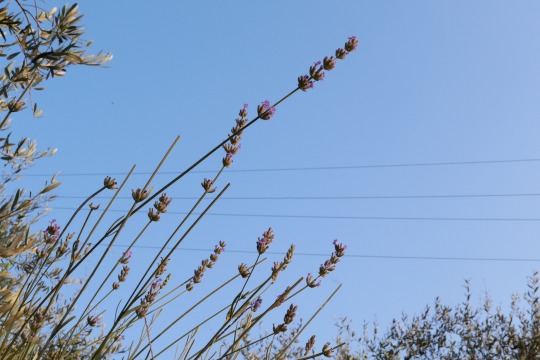

#farm#biodynamicfarming#biologico#nature#lavanda#lavender#aziendaagricolabiodinamica#aziendaagricolabiologica#biodiversity#biodinamica#organicfarming
2 notes
·
View notes
Text


The path of doing
We are approaching the summer solstice, which in our hemisphere represents the longest day of the year. It is the event that marks the beginning of summer, in which the celestial star reaches its zenith and its rays strike our hemisphere perpendicularly. Since ancient times, this moment of welcoming the sun and the ultimate power of nature has been celebrated.
Walking through Lemmen's vineyards, vegetable gardens and orchards, one can clearly sense the apotheosis of the fertility and bounty of the earth and the ripeness and fullness of the plant world.
Flowers are everywhere, and with them come myriads of insects, including bees, bumblebees, wasps and butterflies, foraging for nectar or pollen. Vegetables and fruits take on color amid the endless shades of green given off by the grasses and leaves reaching their brightest and deepest hues.
As we tread the paths immersed in such beauty and diffused with graceful scents, our thoughts return to our own path: an endless apprenticeship and a close and continuous dialogue with the elements of nature.
As the daily toil and difficulties pale in the sunlight, what emerges instead is the gift of having to engage, day after day, in this inexhaustible confrontation.
The period coming to a close has been filled with challenges, one among them the great drought of last year. We like to think that it comes to an end now, with the summer solstice, at the height of brightness and fullness, and that from here it is heading with new strength and clarity toward the next harvest and the beginning of the tenth year of Stella di Lemmen.
Living and learning in nature is an honor and a privilege. Walking the paths of Lemmen is a plunge into the depths of life. Try it to believe: you are all invited.
Il percorso del fare
Ci avviciniamo al solstizio d’estate: il giorno più lungo dell'anno, in cui la luce del sole sconfigge definitivamente le tenebre. È l'evento che sancisce l'inizio dell'estate, nel quale l'astro celeste raggiunge lo zenit ed i suoi raggi colpiscono il nostro emisfero in modo perpendicolare. Fin dall'antichità si è celebrato questo momento di benvenuto al sole e di massimo potere della natura.
Camminando tra i vigneti, gli orti e i giardini di Lemmen si percepisce chiaramente l'apoteosi di fertilità e generosità della terra e di maturazione e pienezza del mondo vegetale.
Fiori ovunque e miriadi di insetti, tra api, bombi, vespe e farfalle, che ne bottinano il nettare o il polline. Ortaggi e frutti che prendono colore tra le infinite sfumature di verde sprigionate delle erbe e dalle foglie che raggiungono le loro tonalità più brillanti e profonde.
Calcando i sentieri immersi in cotanta bellezza e diffusi di leggiadri profumi, il pensiero torna al nostro percorso: un apprendistato infinito e un dialogo serrato e continuo con gli elementi della natura.
E allora la fatica e le difficoltà quotidiane impallidiscono sotto la luce del sole e quello che emerge è invece il dono di doversi cimentare, giorno dopo giorno, in questo inesauribile confronto.
Il periodo che si va a chiudere è stato colmo di sfide, una tra tutte la grande siccità dell'anno scorso. Ci piace pensare che giunga al termine adesso, con il solstizio d'estate, nel culmine della luminosità e della pienezza e che da qui si avvii con nuove forza e chiarezza verso la prossima vendemmia e verso l’inizio del decimo anno di Stella di Lemmen.
Vivere e apprendere nella natura è un onore e un privilegio. Camminare sui sentieri di Lemmen è un tuffo nelle profondità della vita. Provare per credere: siete tutti invitati.
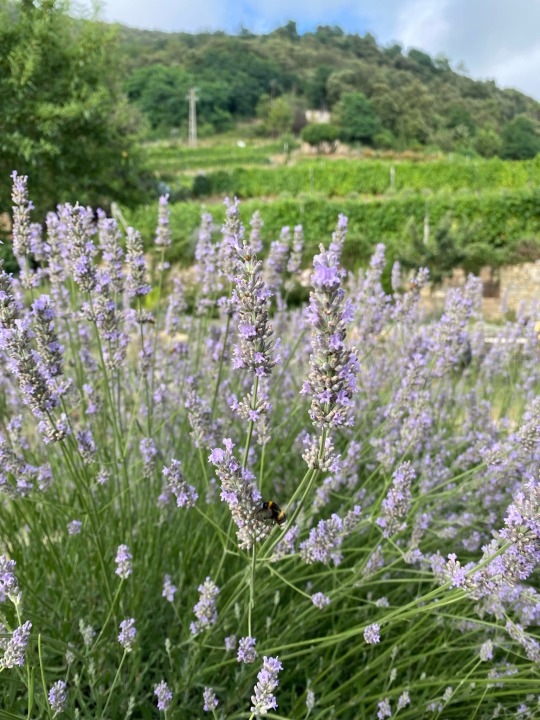
0 notes
Text
Sciacchetrà
In the vineyard we selected the most suitable bunches, those with the most sparse berries, of the Bosco, above all, and Vermentino varieties, which will create our #Sciacchetrà. 🥂
To choose the harvest period we were very careful about the acidity of the grapes, which will balance their increasing sweetness during dehydration. 🍇
We then spread the clusters on the trellises, this year also hanging them from chains.
We let the wind and sun work on the grapes for almost two months. In addition to the dehydration process, endogenous enzymatic processes in the grapes themselves contributed to their complexity. 🌞 💨
On the first days of November, the grapes were taken off the trellises and de-stemmed by hand. 🖐
#sciacchetra#italianwine#farm#wine#biodynamicfarming#biodynamicwine#biologico#farming#biodinamica#cinqueterre#grapes#organic#stelladilemmen#biodynamic#byodinamic#farmer#aziendaagricolabiologica#italy#organicfarm#travel
2 notes
·
View notes
Text
End of the year
Another year has come to an end, and it is time for evaluations. I wander around the countryside in this particularly dark and dank early winter day, before my eyes the heavy rain-soaked ground, the banked mist resting gently on the terraces, the trees and shrubs adorned with pearls of water. Only the temperature does not conform to the time of year, but who expects "normal" weather nowadays?
What appears when the light veil of "caligo" dissipates - as the fog that rises from the sea was called by the Latins - seems like a dream: no longer the barren terraces cleared of scrub and brambles of years past, but a varied and orderly vegetation that feels at ease where it has been placed and enjoys the moisture it has lacked in the interminable summer and fall.
The trunks of the fruit trees are now clearly visible, even if bare; the young olive trees already emanate their quiet tranquility and proudly show their new shoots full of life, with their light green leaflets; the rose bushes with their long falling branches, some of them even still blooming.
This silent order seems like a miracle, like it had always been this way instead of the result of persistent care and attention.
The grayness mutes the tones of the landscape, but it does not dampen the vitality that emanates from it, quite the contrary!
In the dimness, everything seems to want to show more than ever the potential lushness, the regeneration, the promise of life that resides in every branch, every leaf or blade of grass.
What better elixir of life? What more honest reward for the effort put into this undertaking?
Having passed the threshold of six decades, it becomes clear to me as never before how much the "reward" is not so much in the result as in the step by step process. Once again, I thank nature for constantly reminding me: even in the darkest hour, the light shines.
Best wishes for the New Year from all of us at Stella of Lemmen!
Fine dell'anno
Un altro anno è giunto al termine, è tempo di consuntivi. Mi aggiro per la campagna in questo inizio inverno particolarmente buio e uggioso: il terreno pesante impregnato di pioggia, la bruma a banchi che si appoggia delicatamente sulle terrazze, gli alberi e gli arbusti adorni di perle d'acqua. Soltanto la temperatura non è conforme al periodo dell’anno, ma chi si aspetta un clima "normale" ormai?
Quello che appare quando il leggero velo di "caligo" si dilegua - così veniva chiamata la nebbia che s'alza dal mare dai latini - sembra un sogno: non più le brulle terrazze ripulite da macchia e roveti degli anni passati, ma una vegetazione varia e ordinata che si sente a suo agio lì dove è stata posta e si gode l'umidità che le è mancata nell’interminabile periodo estivo e autunnale.
Scorgo i tronchi degli alberi da frutto sono ormai ben visibili, seppur spogli; i giovani ulivi già emanano la loro pacata tranquillità e mostrano orgogliosi e pieni di vita i nuovi germogli con le foglioline verde chiaro; i cespugli di rose con i lunghi rami a cadere, alcuni dei quali addirittura ancora fioriti.
Sembra un miracolo questo ordine silenzioso, sembra essere sempre stato così, non il risultato di persistenti cure e attenzioni.
Il grigiore smorza i toni del paesaggio, ma non attutisce la vitalità che da esso sprigiona, anzi!
Nella penombra, tutto sembra voler mostrare più che mai il potenziale rigoglio, la rigenerazione, la promessa di vita che custodisce ogni ramo, ogni foglia o filo d'erba.
Quale miglior elisir di vita? Quale più onesto compenso all'impegno posto nell’affrontare l'impresa?
Superata la soglia dei sei decenni, mi appare chiaro come non mai quanto la "ricompensa" non sia tanto nel risultato quanto, passo dopo, nel processo. Una volta ancora ringrazio la natura per avermelo costantemente ribadito: anche nel momento più buio risplende la luce.
Un caro augurio per il Nuovo Anno da noi tutti di Stella di Lemmen!
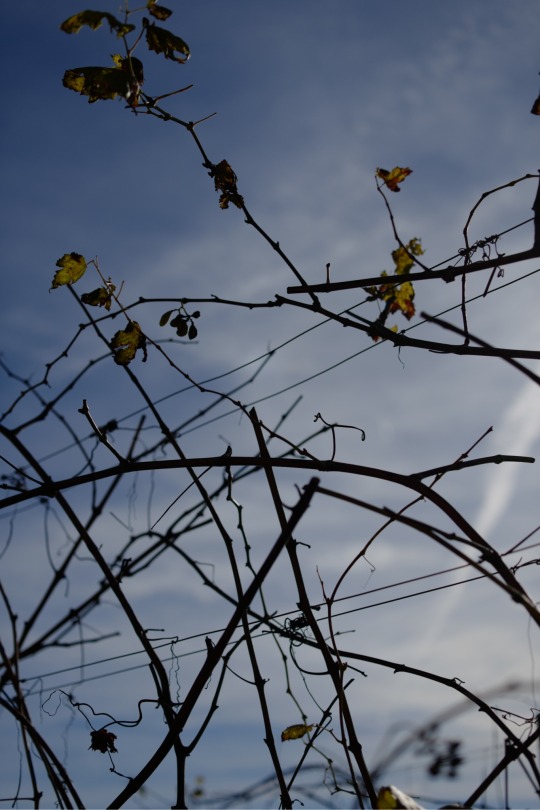



#farm#wine#biodynamicfarming#biodynamicwine#biologico#farming#biodinamica#cinqueterre#grapes#organic#stelladilemmen#byodinamic#biodynamic#aziendaagricolabiologica#farmer#italy#new year#2023
1 note
·
View note
Text


Reaping the rewards
Another vintage has been archived. In our cellar that still smells like new, with the gleaming steels, the pipes along the walls, all the switches and the little lights on the panel as shiny as sparkling candy, the must rests and transforms into wine in its different containers: the vats, the amphorae and a lonely barrique.
It is a unique and somewhat strange thrill to witness the processing of the grapes, if you experience it for the first time...but also if repeated from year to year, as it is always new. And then the waiting: waiting to see what comes out of a year's work in the vineyard, the meticulous selection and harvesting done between the rows, and the winemaking process that, if successful, carries with it the "spirit of the matter."
Now, walking between the rows, we see the vines still covered with green leaves that will soon yellow, but stripped of their berries: we have harvested them. A feeling of relief mixed with a vague, distant sense of emptiness is among us - the end of a cycle has come again this year.
We do not ask the plants for permission to draw the harvest, and it hardly occurs to us that it is the outcome of a transformation: the flower and then the fruit are the consequence of a process that has come to fruition.
This transformation also takes place within us; the result, the fruit, in our case is called wisdom: having "tasted life."
We humans are also called, for our own and others' sake, to express the inexhaustible richness of our inner essence through fruits that are as ripe, as sweet as possible. In this regard, we propose a toast...in the spirit of wine! Cheers!
Raccogliere i frutti
Un'altra vendemmia è stata archiviata. Nella nostra cantina che sa ancora di nuovo, con gli acciai splendenti, i tubi lungo i muri, tutti gli interruttori e le lucine dei quadri lucidi lucidi come scintillanti caramelle, il mosto riposa e si trasforma in vino nei suoi diversi contenitori: i tini, le anfore e una barrique sola soletta.
Un'emozione unica e un po' strana assistere alla lavorazione delle uve, se la si prova per la prima volta...ma anche se ripetuta di anno in anno, in quanto sempre nuova. E poi l'attesa: aspettare per vedere cosa viene fuori da un anno di lavoro in vigna, dalla selezione e dalla raccolta meticolosa effettuate tra i filari e dal processo di vinificazione che, se va a buon fine, reca con sé lo "spirito del discorso".
Adesso, camminando tra i filari, vediamo sfilare le vigne ancora coperte di verdi pampini che presto ingialliranno, ma spogliate delle loro bacche: le abbiamo vendemmiate. Una sensazione di sollievo mista ad un vago, lontano senso di vuoto si affaccia al nostro sentire. Anche quest'anno è giunta la fine di un ciclo.
Non chiediamo permesso alle piante per trarre il raccolto e difficilmente ci sovviene che esso è l’esito di una trasformazione: il fiore e poi il frutto sono la conseguenza di un processo giunto a buon fine.
Questa trasformazione avviene anche dentro di noi, il risultato, il frutto, nel nostro caso si chiama saggezza: l'aver "assaggiato la vita".
Anche noi umani siamo chiamati, per il nostro e l'altrui bene, ad esprimere l'inesauribile ricchezza della nostra intima essenza attraverso dei frutti che siano il più maturi, il più dolci possibile. A questo proposito proponiamo un brindisi...con lo spirito del vino! Salute!







5 notes
·
View notes
Text

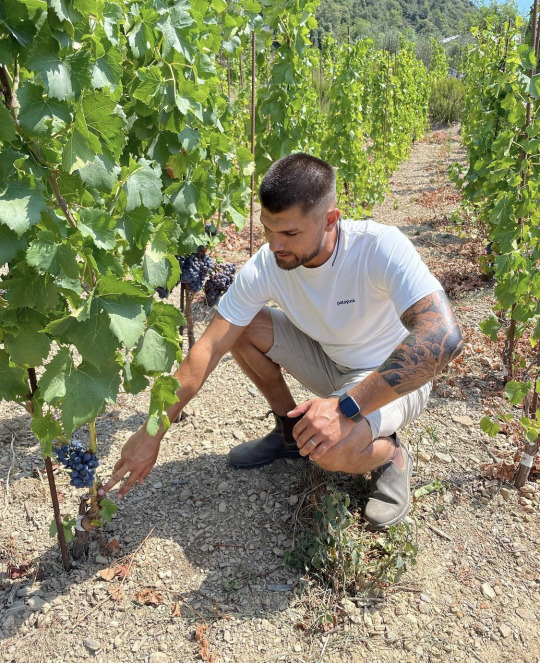
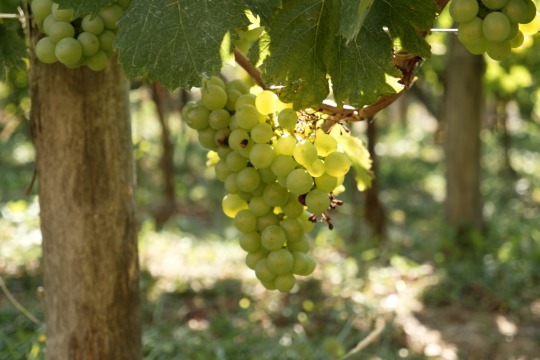
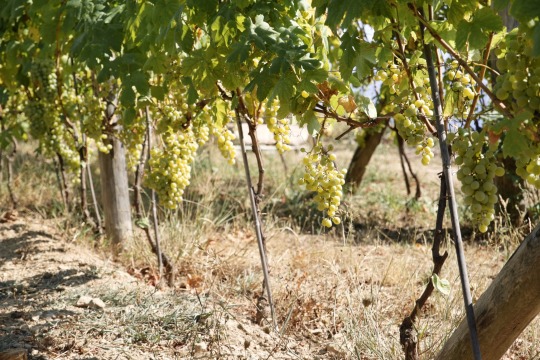
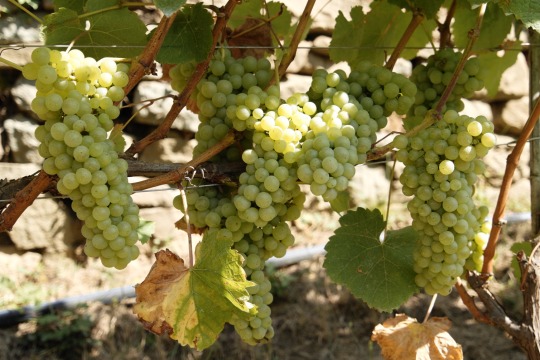
A summer on fire
Summer is ending with record temperatures across the Northern Hemisphere. But how has this affected agriculture, the grapevine in particular, and what can we expect from the 2022 harvest?
What is coming to an end has been a period of great drought and heat here in Stella di Lemmen as well. It has challenged the course of the seasons, the land and us workers. This is also why we have not been able to update our „logbook“ regularly in recent times.
The first three months of the year went by without any precipitation - we started watering in January/February! - and were interrupted only by a few scant rains in April. This led to a spring that exploded and petered out in record time, as the early warm weather soon evaporated the little moisture in the soil and plants flowered and wilted within a few weeks. One example for all: lavender, which usually blooms from early July to mid-August, had already withered by the end of June.
Trees and flora ran for cover, trying to go to seed in a great hurry to ensure reproduction before the eventual passing due to heat and drought.
Fire temperatures and no water, just a single thunderstorm from May to mid-August! All the plants suffered from the pressing heat and many, even some rosemaries, did not make it. The fatigue of the plant world was so obvious that we could not shield ourselves to be shaken by it as well.
The animals faced the heatwave by resting interminable hours motionless, seeking shade from late morning until evening.
Fortunately, in the period up to the solstice the temperature range helped, bestowing coolness and a little moisture in the night and early morning hours.
As the only exception, the vineyard coped fairly well with the sunny summer and drought, evidently benefiting from the cultivation techniques we employ and despite the fact that not a drop of irrigation was lavished on it. The ripening of the grapes developed quite evenly, slightly better in the areas where - paradoxically - the plants had less vigor. The result is a copious harvest that will soon, exceptionally soon, have to be collected and turned into wine.
The abundance of grapes will allow us, for the first time, to select the best bunches for our „Limen“, the Cinque Terre white, and to tackle some new experiments, with amphorae and barriques, aimed at growth and the pursuit of excellence.
The red grapes, of the Grenache and Canaiolo varieties, will also be a first: the first harvest! We are really excited and, as per our nature, a tiny bit anxious… :)
Now that two copious thunderstorms have returned to wet the land, and nature as a whole has been able to take a breather, we hope for a harmonious resumption of rainfall and a consequent, gradual return to normality. Plants, animals and we farmers will hopefully be able to breathe a sigh of relief.
Let's see if nature, generous as always, as a result of this difficult period will reward us with some wonderful surprises. After all... „in vino veritas“, „in wine lies the truth“!
Un’estate di fuoco
L'estate si sta concludendo con temperature record in tutto l'emisfero boreale. Ma come questo ha inciso sull’agricoltura? Che conseguenze ha sulla vite e cosa ci si può aspettare dalla vendemmia 2022?
Quello che giunge al termine è stato un periodo di grande siccità e caldo anche qui a Stella di Lemmen. Ha messo a dura prova il corso delle stagioni, la terra e noi lavoratori. Anche per questo negli ultimi tempi non ci è stato possibile aggiornare con regolarità il nostro „giornale di bordo“.
I primi tre mesi dell’anno senza precipitazioni - abbiamo iniziato ad annaffiare a gennaio/febbraio! - sono stai interrotti solo da qualche scarsa pioggia ad aprile e hanno portato ad una primavera esplosa ed esauritasi a tempo di record, perché i primi caldi hanno presto fatto evaporare la poca umidità presente nel terreno e le piante sono fiorite ed appassite nel giro di poche settimane. Un esempio per tutte: la lavanda, che di solito fiorisce dai primi di luglio a metà agosto, a fine giugno era già sfiorita.
Gli alberi e la flora sono corsi ai ripari, cercando di andare a seme in grande fretta, per garantire la riproduzione prima dell’eventuale trapasso a causa del calore e della siccità.
Temperature di fuoco e niente acqua, un unico temporale da maggio a metà agosto! Tutte le piante hanno sofferto la pressante calura e in tante, addirittura alcuni rosmarini, non ce l’hanno fatta. Troppo evidente la fatica del mondo vegetale per non rimanerne scossi anche noi.
Gli animali hanno affrontato la canicola riposando interminabili ore immobili, ricercando l’ombra dalla tarda mattinata fino a sera.
Per fortuna, nel periodo fino al solstizio l’escursione termica ha aiutato, elargendo frescura e un poco di umidità nelle ore notturne e di primo mattino.
Come unica eccezione, il vigneto ha retto egregiamente all’estate assolata e alla siccità, beneficiando evidentemente delle tecniche colturali che utilizziamo e nonostante non una goccia di irrigazione gli sia stata elargita. La maturazione delle uve si è sviluppata in maniera omogenea, leggermente migliore nelle zone dove – paradossalmente – le piante presentavano meno vigoria. Il risultato è un raccolto copioso che a breve, eccezionalmente presto, dovrà essere vendemmiato e trasformato in vino.
L’abbondanza di uva ci consentirà per la prima volta di selezionare i grappoli migliori per il nostro „Limen“, il bianco delle Cinque Terre, e di affrontare qualche nuovo esperimento, con anfore e barrique, mirato alla crescita e alla ricerca dell’eccellenza.
Anche il rosso, varietà Grenache e Canaiolo, sarà una novità assoluta: il primo raccolto! Siamo davvero entusiasti e, come da nostra natura, un briciolo ansiosi…
Ora che due copiosi temporali sono tornati a bagnare la terra e la natura tutta ha potuto prendere respiro, si spera in un'armonica ripresa delle precipitazioni ed un conseguente, graduale, ritorno alla normalità. Le piante, gli animali e noi contadini potremo auspicabilmente tirare un sospiro di sollievo. Chissà se la natura, generosa come sempre, come risultato di questo difficile periodo ci premierà con qualche meravigliosa sorpresa. In fondo...“in vino veritas“!
1 note
·
View note
Photo


There are three ways
There are three ways to reach Stella di Lemmen, always and exclusively on foot: ascending from the path that starts from the coastal road, descending from the Telegrafo or, in the opposite direction, taking the path that leads from the Sanctuary of the Madonna di Montenero to the Telegrafo (and then on to Portovenere).
The latter option, which intersects the farm about halfway through, on a flat section of the path, is certainly the most striking.
The view from the plateau of the Sanctuary, at the start, is breathtaking: the sea with a wide stretch of coastline both east and west seems to loom up to embrace us, while the shade of the pines around the building provides friendly shelter.
Continuing along the trail, after a sharp right turn slightly uphill, the path becomes flat again and shortly afterwards we can see below the "Costa de Sera" with its fields sloping down to the sea.
Once we reach the beautiful vineyard of "Travandasca," tended by its owners Mario and Luciano, the view of Stella di Lemmen opens up in the distance, and from there on appears and disappears multiple times, interrupted by heather, patches of broom or tall trees such as turkey oaks and chestnuts.
As we approach the farm step by step, the view overlooks the terraces, vineyards, vegetable gardens, and trees, and a feeling of peace and harmony, of great tranquility presents itself to our hearts.
When finally the whole view opens to Stella di Lemmen, it is impossible not to feel a vague astonishment, like when the magician pulls the white rabbit out of the hat: "but...what's going on?!"
The farm, still a work in progress, is the largest in the Cinque Terre in terms of cohesive land area, and is the only biodynamic agricultural organism in the region.
It is now eight years that we have been taking care of this place and that this place has been taking care of us, a challenging and increasingly intense "dialogue" that goes on day after day. A continuous confrontation with the earth, with plants and animals, with weather events, the sky, the moon...and the stars.
As far as we can, we try more than anything else to "listen," because in our opinion it is the right key, the only plausible one to act in harmony with nature and to be able to keep the spirit of the place unchanged - or more, well alive.
The Cinque Terre are in their entirety a magical place, vibrant with energy and uniquely beautiful. Set in this context, Stella di Lemmen can really shine, enriched by the potential of the virtuous circle that is triggered when we humans respect what is beautiful, precious and true around us.
Ci sono tre modi
Ci sono tre modi per raggiungere Stella di Lemmen, sempre e solamente a piedi: salendo dal sentiero che parte dalla strada litoranea, scendendo dal sentiero del Telegrafo oppure, in direzione opposta, imboccando il sentiero che dal Santuario della Madonna di Montenero porta al Telegrafo (e prosegue poi per Portovenere).
Quest’ultima opzione, che interseca circa a mezza altezza l’azienda con un tratto di cammino pianeggiante, è certamente la più suggestiva.
Il panorama dal pianoro del Santuario, alla partenza, è mozzafiato: il mare con un ampio tratto di costa sia a est che a ovest sembra incombere fino a volerci abbracciare, mentre l’ombra dei pini intorno alla costruzione fornisce un’amichevole riparo.
Continuando il percorso, dopo una decisa svolta a destra in leggera salita, il sentiero torna pianeggiante e poco dopo si può ammirare in basso la “Costa de Sera” con i suoi campi che scendono fino al mare.
Una volta raggiunto il bel vigneto di “Travandasca”, curato dai suoi proprietari Mario e Luciano, ecco aprirsi in lontananza la visuale su Stella di Lemmen che da lì in poi appare e scompare interrotta a tratti dalle eriche, da macchie di ginestre, o da piante ad alto fusto come cerri e castagni.
Mentre ci avviciniamo, passo dopo passo, la vista si affaccia sui terrazzamenti, sui vigneti, gli orti, i giardini e gli alberi, ed una sensazione di pace e armonia, di grande tranquillità si presenta al nostro cuore.
Quando infine l’intera visuale si apre su Stella di Lemmen, è impossibile non provare un vago stupore, come quando il prestigiatore tira fuori il coniglio bianco dal cappello: “Ma...che cosa succede?!”
L’azienda, ancora in divenire, è la più grande delle Cinque Terre per estensione di terreni accorpati e rappresenta l'unico organismo agricolo biodinamico della zona.
Sono ormai otto anni che ci prendiamo cura di questo luogo e che questo luogo si prende cura di noi, un “dialogo” impegnativo e sempre più intenso che va avanti giorno dopo giorno. Un confronto continuo con la terra, con le piante e con gli animali, con gli eventi atmosferici, il cielo, la luna...e le stelle.
Per quanto ci è possibile cerchiamo più che altro di “ascoltare”, perché questa secondo noi è la chiave giusta, l’unica plausibile per agire in armonia con la natura e poter mantenere inalterato – o di più, ben vivo – lo spirito del posto.
Le Cinque Terre sono nella loro interezza un luogo magico e vibrante di energia, di una bellezza unica al mondo. Stella di Lemmen splende incastonata in questo contesto, arricchita dal potenziale del circolo virtuoso che si innesca quando noi umani rispettiamo quanto c’è di bello, di prezioso e di vero intorno a noi.
#stelladilemmen#cinqueterre#Italy#trekking#camminando#cammino#aziendaagricolabiologica#aziendaagricolabiodinamica#biodinamica#biologico#agricolturabio#biodynamic#biodynamicwine#biodynamicfarming#organic#organicfarm#farm
1 note
·
View note
Text

Eggs and Easter
Egg production from our hens is at an all-time high. Every day, twenty to thirty exquisite eggs are at our disposal and are punctually distributed among us or to friends and collaborators passing by.
It's hard to find tastier eggs: Stella di Lemmen's hens, which during the night are closed in several small hen houses distributed around the farm, in order to protect them from predators, during the day are free to roam in the vineyards and fields, in the woods and in the olive groves...and alas sometimes even in the vegetable gardens, where they really shouldn't!
Each family, headed by a rooster, is scattered throughout the territory without interfering or engaging in disputes with the others. Similarly, the different breeds - dwarf or regular - do not mix with each other but form well-assorted and homogeneous groups.
The high quality of the eggs is closely related to the variety of the diet: the chickens can eat, as they like, the organic feed we give them, but also grass and various seasonal vegetables and, above all, insects and larvae, of which they are greedy and which characterize their omnivorous, not vegetarian, diet.
The fact that chickens roam the fields is also healthy for the vineyard and other vegetation, because they raid insects that can damage crops. An example among many is the "Noctua fimbriata", a moth that deposits its eggs in the crevices of the bark of the vine and whose larvae, in spring, feed on the new buds, destroying the vegetation and ultimately causing the death of the plant.
Our eggs have different colors and sizes depending on the size of the breed: white, red, pink, even blue or green if they are from "Araucana" hens or chocolate colored if they are from "Marans".
Of course, hens lay eggs to ensure the continuity of specialization and not our production of excellent omelets...for this reason springtime is all a fervor of hens brooding, sometimes disappearing to build nests in secluded places, then reappearing suddenly with the chicks in tow.
The egg is a symbol of new life and rebirth. Since the Middle Ages, people in Germany used to give boiled eggs (wrapped in leaves and flowers so that they would dye naturally) as a good omen for Easter. To celebrate Spring, the Persians gave eggs as a wish for a new beginning, while for the ancient Egyptians the egg was the origin of everything and the fulcrum of the four elements (air, water, earth and fire) - in short: of life!
The Christian tradition associates the egg with the resurrection of Christ, and later in time, the sweetness of the chocolate eggs that were given as gifts to cheer Easter (they say by a Turin pastry chef) was completed by the addition of a small surprise inside.
Even for us the birth of a chick, from that unfathomably intact and perfect casket, is always a surprise, a promise of life that comes true.
Let us celebrate this promise together! Let us reflect on the importance of life, on its uniqueness and sacredness, on the fact that it is our task and duty to preserve and protect it rather than hinder and destroy it.
Honoring life and our humanity is a duty, because we really need it, because we urgently need it.
Happy Easter from Stella di Lemmen!
Uova e Pasqua
La produzione di uova delle nostre galline è al massimo. Ogni giorno venti/trenta uova squisite sono a nostra disposizione e vengono puntualmente distribuite tra di noi o ad amici e collaboratori di passaggio.
Difficilmente si possono trovare uova migliori: le galline di Stella di Lemmen, che di notte vengono chiuse in diversi piccoli pollai distribuiti nell'azienda in modo da proteggerle dai predatori, di giorno sono libere di razzolare nelle vigne e nei campi, nel bosco e nell'uliveto...e ahinoi a volte anche negli orti, dove non devono!
Ogni famiglia, con a capo un gallo, si distribuisce sul territorio senza interferire o ingaggiare dispute con le altre. Allo stesso modo le diverse razze - nane o regolari - non si mischiano tra di loro ma formano dei gruppetti ben assortiti ed omogenei.
L'alta qualità delle uova è strettamente correlata alla varietà dell'alimentazione: i polli possono mangiare a loro gradimento il mangime biologico che gli viene da noi elargito, erba e vegetali vari di stagione e soprattutto insetti e larve, dei quali sono ghiotti, che contraddistinguono la loro alimentazione onnivora, non vegetariana.
Che le galline scorrazzino per i campi è salutare anche per la vigna e le altre vegetazioni, perché fanno razzia di insetti che possono danneggiare le coltivazioni. Un esempio tra tanti è la "Noctua fimbriata" , una falena che deposita le uova negli anfratti della corteccia della vite e le cui larve, a primavera, si cibano delle nuove gemme distruggendo la vegetazione fino a causare la morte della pianta.
Le nostre uova hanno diversi colori e formati a seconda della grandezza della razza: bianche, rosse, rosa, addirittura azzurre o verdi se si tratta di galline "Araucana" o color cioccolato se sono "Marans".
Certo, le galline depongono le uova per assicurare la continuità della specializzazione e non la nostra produzione di ottime frittate...per questo a primavera è tutto un fervore di chiocce che covano, a volte scomparendo per costruirsi nidi in luoghi appartati ed introvabili, ricomparendo poi, all’improvviso, con i pulcini al seguito.
L'uovo è un simbolo di nuova vita e di rinascita. Fin dal medioevo, in Germania si usava regalare uova bollite avvolte in foglie e fiori in modo che si tingessero naturalmente, come buon auspicio per Pasqua. Per celebrare la Primavera, i Persiani regalavano uova come augurio per un nuovo inizio, mentre per gli antichi Egizi l'uovo era l'origine di tutto e il fulcro dei quattro elementi (aria, acqua, terra e fuoco) - in poche parole: della vita!
La tradizione Cristiana associa l'uovo alla resurrezione del Cristo e più avanti nel tempo, alla dolcezza delle uova di cioccolata che si regalavano per allietare la Pasqua (dicono ad opera di un pasticcere torinese) viene aggiunta all’interno una piccola sorpresa.
Anche per noi la nascita di un pulcino, da quell'insondabile scrigno integro e perfetto, è sempre una sorpresa, una promessa di vita che si avvera.
Celebriamo insieme volta questa promessa! Riflettiamo sull'importanza della vita, sulla sua unicità e sacralità, sul fatto che è nostro compito e dovere preservarla e proteggerla piuttosto che ostacolarla e distruggerla.
Onorare la vita e la nostra umanità è un dovere, perché ne abbiamo davvero bisogno, perché ne abbiamo urgenza.
Buona Pasqua da Stella di Lemmen
2 notes
·
View notes
Text
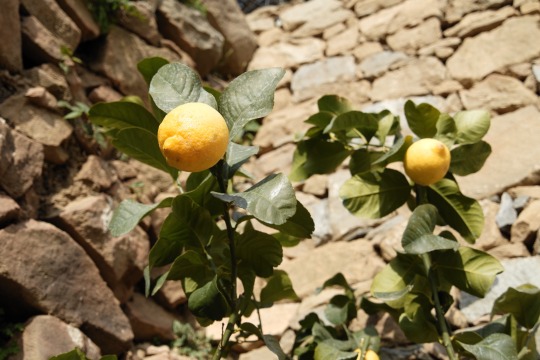
Shopping for citrus
Sometimes the urge to go shopping becomes irresistible and leads us to wander around town looking for clothes, shoes or bags....
Even at Stella di Lemmen we are not immune to the shopping fever, but instead of clothing, from time to time we have to satisfy our need for...plants!
When that's the case, we take the van and head to the Pistoia, Tuscany area, famous for its countless plant nurseries. This time we were in need of citrus plants, to be put along the walls of the olive grove. So we went to the fantastic nursery of the Lenzi family @agrumilenzi, where you can find an endless choice of the most aromatic, curious and multicolored varieties of citrus. This family of plants is characterized by a great ease of crossing: all the varieties we know are combinations and recombinations of the three "ancestor" varieties, mandarin, citron and pomelo. In addition to the best known fruits, such as oranges, lemons and grapefruit, over the centuries chinotto, kumquat, yuzu, bergamot, finger lime and so on were created. And we, on our shopping tour, bought some of each one of them!
These days the young trees are being planted, interspersed among the olive trees. In a few years, the juicy fruits and fragrant peels full of essential oils will be the base of lemonades, jams, syrups, hydrolates and much more.
A spesa di agrumi
A volte la voglia di shopping diventa irresistibile e ci porta a girare per la città alla ricerca di vestiti, scarpe o borse...
Anche a Stella di Lemmen non siamo immuni dalla febbre dello shopping, ma al posto dell'abbigliamento di tanto in tanto dobbiamo soddisfare il nostro bisogno di...piante!
Quando è così, prendiamo il furgone e ci muoviamo verso la zona di Pistoia, in Toscana, famosa per i suoi innumerevoli vivai. Questa volta necessitavamo di piante di agrumi, da mettere a spalliera lungo i muri dell'uliveto. Siamo quindi andati al fantastico vivaio della famiglia Lenzi @agrumilenzi, dove si può trovare una scelta infinita delle più aromatiche, curiose e multicolori varietà di agrumi. Questa famiglia di piante è caratterizzata da una grande facilità di incrocio: tutte le varietà che conosciamo sono combinazioni e recombinazioni delle tre varietà "antenate", mandarino, cedro e pomelo. Oltre ai frutti più conosciuti, come arance, limoni e grapefruit, nel corso dei secoli sono stati creati chinotti, kumquat, yuzu, bergamotti, finger lime e così via. E noi, nel nostro shopping tour, ne abbiamo comprati di tutti un po'!
In questi giorni gli alberelli vengono messi a dimora, intercalati tra gli ulivi. Tra qualche anno, i frutti succoso e le odorose bucce piene di oli essenziali saranno la base di limonate, marmellate, sciroppi, idrolati e molto altro.


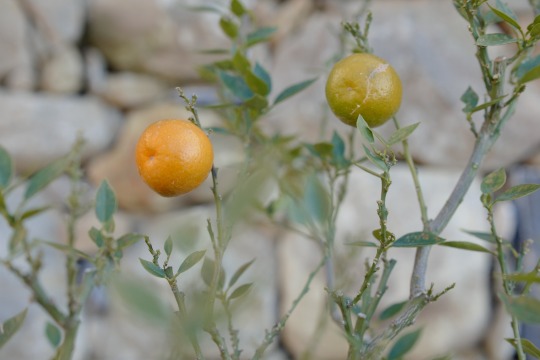
3 notes
·
View notes
Text



A new apiary
We moved our apiary from the west to the east, expanding it considerably.
The original one, which had fifteen hives, had been temporarily placed on the western edge of the farm, high up near the woods.
After a long preparation of the new dedicated area, everything was finally ready to host the old and the new colored hives. Daniele and Jacopo carefully closed the original hives, moved them with a quite bizarre DIY carrier from the old to the new location and placed them in good order along the support that lifts them off the ground, together with the many freshly painted hives we added.
The bees had to get used to the new geographical coordinates by being locked in for three days. We supplied them with water (sprinkling it on the grid every day) and food (sugar syrup) to alleviate the stress of the confinement...but when we reopened the hives, they weren't happy at all - in fact, I'd say they were rather nervous!
The additional young families arrived in Lemmen in polystyrene hives and, after a week of stay to get used to the place, they will be transferred to their new homes. We wanted to paint the new hives ourselves, choosing shades as close as possible to the floral colors of Stella di Lemmen.
The production of honey, for a permanent apiary like ours, is marked by the seasonality of the predominant flowering: during the year we have heather, then acacia and finally chestnut. Our honeys, however, always acquire a further aromaticity given by the many blooms that follow one another throughout the year.
Our extreme attention to biodiversity and the consequent multitude of aromatic, medicinal or simply flowering and decorative plants that are guests of the farm, makes the collection of nectar by bees particularly varied and the bouquet of resulting honeys exceptionally flowery. A real treat for the palate, try it to believe!
Following the enlargement of the apiary, we will increase the number of Mediterranean plants and fruit trees to continue to guarantee our bee friends delicious and diversified spoils, excellent for their and our health. But back to the present: dear bees, welcome to your new apiary, wonderful, precious creatures of the air!
Un nuovo apiario
Abbiamo spostato il nostro apiario da ovest a est, ampliandolo notevolmente.
Quello originale, che contava quindici arnie, era stato provvisoriamente posto ai margini occidentali dell'azienda, in alto, al limitare del bosco.
Dopo un lungo lavoro di preparazione della nuova area dedicata era finalmente tutto pronto per ospitare le vecchie e le nuove casette colorate. Daniele e Jacopo hanno chiuso con cura le arnie originali, le hanno spostate con una bizzarra portantina fai da te dalla vecchia alla nuova location e le hanno appoggiate in bell'ordine lungo il supporto che le solleva da terra, insieme alle tante arnie fresche di pittura che abbiamo aggiunto.
Le api si sono dovute abituare alle nuove coordinate geografiche rimanendo chiuse dentro per tre giorni. Le abbiamo rifornite di acqua (spruzzandola ogni giorno sulla grata della chiusura) e di cibo (sciroppo di zucchero) per alleviare lo stress della clausura...ma quando le abbiamo riaperte non erano per nulla contente, anzi direi piuttosto innervosite!
Le giovani famiglie aggiuntive sono invece giunte a Lemmen in alveari di polistirolo e, dopo una settimana di permanenza per abituarsi al luogo, verranno trasferite nelle nuove arnie di legno dai colori pastello, come quelli dei fiori. Abbiamo voluto dipingere noi stessi le nuove dimore scegliendo tonalità il più possibile vicine alle colorazioni floreali di Stella di Lemmen.
La produzione del miele, per un apiario stanziale come il nostro, è scandita dalla stagionalità della fioritura preponderante: nel corso dell'anno troviamo l'erica, poi l'acacia ed infine il castagno. I nostri mieli però acquistano sempre un'ulteriore aromaticità data dalle molteplici fioriture di contorno che si susseguono durante tutto l'anno.
Proprio il nostro estremo riguardo alla biodiversità e la conseguente moltitudine di piante aromatiche, officinali o semplicemente da fiore e decorative ospiti dell'azienda, rende la raccolta del nettare da parte delle api particolarmente varia e il bouquet dei mieli che ne derivano eccezionalmente fiorito. Una vera delizia per il palato, provare per credere!
In seguito all'ampliamento dell'apiario, sarà nostra cura aumentare il numero delle piante mediterranee e degli alberi da frutto, per continuare a garantire alle nostre amiche api bottini golosi e diversificati, ottimi per la loro e la nostra salute. Ma tornando al presente: care api, benvenute nel vostro nuovo apiario, meravigliose, preziosissime creature dell'aria!


0 notes
Text

She is Ping Pong
Do you want to know why she's called Ping Pong? Because she has only one leg and she moves, even very quickly, bouncing exactly like a ping pong ball does.
When she was little more than a chick, she was the victim of a raid by the marten, who grabbed her through the chicken coop's net by one leg and pulled it off.
It seemed as if she wouldn't survive: for days she remained motionless, with her eyes closed, without strength and without eating.
Then the wound healed, she began to stand on one leg for brief moments, to drink and peck a little bit. Every morning she was picked up and transferred from her cage to the ground, next to food and water, and every evening she was lifted up and laid on the straw of the egg box in the chicken coop - of course with additional cuddles and scratches under her beak that she showed her appreciation for, tenderly squinting her eyelids.
This procedure has become a ritual: although she can now leap out of the hen house and even hop back in, she prefers to wait for someone to accompany her, to say hello and wish each other goodnight.
For almost a year she has remained exceptionally light, like a feather, so much so that in lifting her day after day we were amazed at her insubstantiality: it seemed like lifting nothing!
At the same time we could never help but feel her gratitude for that help and for that fleeting moment when she was held in our arms and pampered.
Today, although she hasn't reached the size of her companions, she has her own weight and above all a beautiful and soft bright red plumage. She juggles skillfully among the others in the conquest of food and stands out for her ardor, attention and wit. Every so often she even gives us an egg!
Sometimes, exceptionally, she is allowed to stay in the meadow in front of the house, where she proudly wanders around bouncing among the grass, almost as if she were aware of her privilege.
It is not easy to describe the relationship between such a simple animal - which many would define as banal or even stupid - and its keeper, but there is no doubt that a current of particular empathy can be established between him and the human.
Perhaps it is the animals that acquire qualities when a particular closeness is established with us humans. Ping Pong is one example, but undoubtedly animals are not the only ones who benefit from this exchange...
Lei è Ping Pong
Volete sapere perché si chiama Ping Pong? Perché ha una zampa sola e si sposta, anche molto velocemente, rimbalzando esattamente come fa una pallina da ping pong.
Quando era poco più di una pollastrella è stata vittima di un'incursione della faina, che l'ha agguantata attraverso la rete del pollaio per una zampa e gliel'ha staccata.
Sembrava non dovesse sopravvivere: per giorni è rimasta immobile, con gli occhi chiusi, priva di forze e senza mangiare.
Poi la ferita si è rimarginata, ha cominciato a reggersi su una zampa sola per brevi momenti, a bere e a becchettare qualcosa. Tutte le mattine veniva presa in braccio e trasferita dalla gabbia al suolo accanto al cibo e all'acqua, e tutte le sere sollevata e adagiata sulla paglia della cassetta delle uova nel pollaio - naturalmente con corredo di coccole e grattatine sotto il becco che mostrava apprezzare, socchiudendo teneramente le palpebre.
Questa procedura è diventata un rituale: nonostante adesso riesca a uscire a balzi dal pollaio e sia anche in grado di rientrare, preferisce aspettare che la si accompagni, per salutarsi ed augurarsi reciprocamente la buona notte.
Per quasi un anno è rimasta eccezionalmente leggera, come una piuma, tanto che nel sollevarla giorno dopo giorno si rimaneva stupiti della sua inconsistenza: sembrava di sollevare il nulla!
Allo stesso tempo non abbiamo mai potuto fare a meno di percepire la sua gratitudine per quell'aiuto e per quel fugace momento in cui viene tenuta in braccio e vezzeggiata.
Adesso, pur non avendo raggiunto la stazza delle sue compagne, ha un suo peso e soprattutto un bellissimo e soffice piumaggio rosso vivo. Si destreggia abilmente tra le altre alla conquista del cibo e si distingue per ardore, attenzione ed arguzia. Ogni tanto ci elargisce anche un ovetto!
A volte, eccezionalmente, le viene concesso di soggiornare nel prato di fronte a casa, dove si aggira orgogliosa rimbalzando tra le erbette, quasi fosse consapevole del suo privilegio.
Non è facile descrivere il rapporto tra un animale così semplice - che molti definirebbero banale o addirittura stupido - e il suo custode, ma è indubbio che una corrente di particolare empatia possa instaurarsi tra lui e l'umano.
Forse sono gli animali che acquisiscono qualità quando si instaura una particolare vicinanza con noi umani. Ping Pong ne è un esempio, ma indubbiamente non sono gli animali i soli a beneficiare di questo scambio...
1 note
·
View note
Text

An educational trip to Trentino Südtirol
This weekend, Kostantin and I participated in a course by Cambium Formazione on the introduction of animals to farms and how they should be cared for.
After passing through the "gates" of Trentino, represented by the austere fortresses that are imposed on the view of the traveler coming from the south along the Adige Valley, we arrived in Mezzolombardo, almost at the border with South Tyrol. There lies the Foradori Winery, which kindly hosted the first part of the internship conducted by Adriano Zago, an enologist and agronomist who collaborates with Stella di Lemmen and many other organic and biodynamic wineries. With him, in the role of main teacher, the veterinarian Marcello Volanti from Verona.
Foradori, with its wineries, vegetable gardens and part of the vineyards, is set in the heart of the village. Once crossed the portal of the estate, it is possible to perceive a flow of order and harmony emanated by the deep synergy between man and nature.
Elisabetta Foradori is responsible for this enchantment: she was able to lead the winery, established in the beginning of the 1900's, towards economic success, but most of all - supported by the impulse of her husband Rainer Zierock - towards ontological success, which happens when human beings and nature communicate and go on together.
So now, to close the circle, several happy bovines graze in the vineyards of the Foradori winery and contribute to the success of its legendary wines, which reach sixty countries of the planet.
There could not have been a better location to listen to the heartfelt indications of our veterinary teacher, vigilant and prepared, who suggested us many important points to think about.
The next day, visits to the marvelous biodynamic farms of South Tyrol Manincor and Lageder allowed us to verify even more how animals can be limpidly integrated into the agricultural organism, enriching it with value and content.
Kostantin rightly noted how respect for the animal allows it to relate to man, in the fullness of its own ease, as a particular entity and not just as part of a group.
Personally, the topic that struck me the most among the many aspects discussed was the one concerning the death of the animal, a delicate issue often neglected or experienced with embarrassment, although it is a natural part of the cycle of breeding and therefore should be addressed with serenity.
Marcello Volanti pointed out that animals live in the present, they remember negative experiences but do not have a sense of death. Basically, if they live well, death does not represent a problem for them; this brought back to my mind the passage of the Apocalypse: "It is done! I am the Alpha and the Omega, the Beginning and the End. To the thirsty I will give freely from the spring of the water of life." (21:6).
Thanks to all of our hosts, I continue to meditate while gazing at the shining snowy peaks of Trentino in silence. Soon we will have to leave and return to the sea.
Un viaggio istruttivo in Trentino Alto Adige
Questo fine settimana io e Kostantin abbiamo partecipato al corso di Cambium Formazione sull’introduzione degli animali in azienda e su come andrebbero accuditi per il loro benessere.
Dopo aver varcato le "porte" del Trentino, rappresentate dalle austere rocche che si impongono alla vista del viaggiatore proveniente da sud percorrendo la valle dell'Adige, siamo arrivati a Mezzolombardo, quasi al confine con l’Alto Adige. Lì si trova l'Azienda Agricola Foradori, che ha gentilmente ospitato la prima parte dello stage condotto da Adriano Zago, enologo e agronomo che collabora con Stella di Lemmen e con molte altre aziende biologiche e biodinamiche. Con lui, nella veste di docente principale, il veterinario Marcello Volanti di Verona.
Foradori, con le sue cantine, gli orti e una parte dei vigneti è incastonata nel cuore del paese. Varcato il portale della tenuta si percepisce un flusso di ordine e armonia sprigionato dalla profonda sinergia tra umano e natura.
Di quest’incanto è responsabile Elisabetta Foradori, che ha saputo traghettare l’azienda, nata nel primi del Novecento, verso il successo economico, ma soprattutto - sostenuta dall’impulso del marito Rainer Zierock - il successo ontologico, che si verifica quando l’essere umano e l’essere della natura comunicano e procedono di concerto.
Così adesso, a chiusura del cerchio, alcuni felici bovini pascolano nei vigneti dell’Azienda Foradori, e contribuiscono alla riuscita dei suoi leggendari vini, che raggiungono sessanta paesi del pianeta.
Non poteva esserci migliore location per ascoltare le accorate indicazioni del nostro docente veterinario, vigile e preparato, che ci ha suggerito numerosi spunti importanti sui quali riflettere.
Il giorno successivo, le visite alle meravigliose Aziende Agricole biodinamiche dell’Alto Adige Manincor e Lageder hanno permesso di verificare ancor più come gli animali possano integrarsi limpidamente nell’organismo agricolo, arricchendolo di valore e di contenuti.
Kostantin ha giustamente notato come il rispetto per l’animale consente a quest’ultimo di rapportarsi con l’uomo, nel pieno del suo proprio agio, come entità particolare e non solo come parte di un gruppo.
Personalmente, l’argomento che più mi ha colpito tra i numerosi aspetti trattati è stato quello che riguarda la morte dell'animale, tema delicato ma spesso trascurato o vissuto con imbarazzo, pur facendo naturalmente parte del ciclo dell'allevamento e dovendo quindi venire affrontato con serenità.
Marcello Volanti ha sottolineato che gli animali vivono nel presente, ricordano l’esperienza negativa ma non hanno un’immagine della morte. In sostanza, se vivono bene la morte non costituisce un problema per loro; questo mi ha riportato alla memoria la frase dell’Apocalisse: "Ogni cosa è compiuta! Io sono l'Alfa e l'Omega, il principio e la fine; a chi ha sete Io darò in dono della fonte dell'acqua della vita." (21:6).
Grazie a tutti i nostri ospiti, continuo a meditare osservando le splendenti cime innevate del Trentino in silenzio. Presto dovremo partire per fare ritorno al mare.



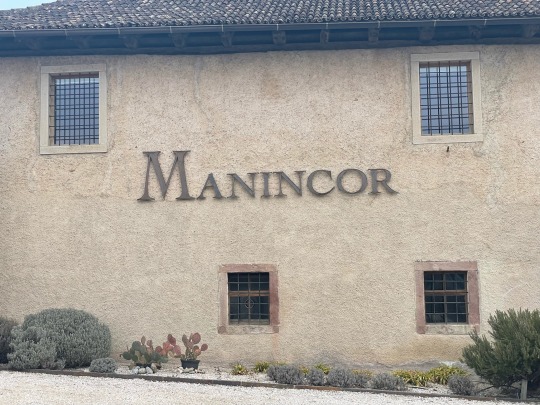





#farm#wine#farming#biodynamicfarming#biodynamicwine#biologico#grapes#biodinamica#byodinamic#farmer#stelladilemmen#organic#cambium#cambiumformazione#formazione#foradori#Manincor#Lageder
1 note
·
View note
Text
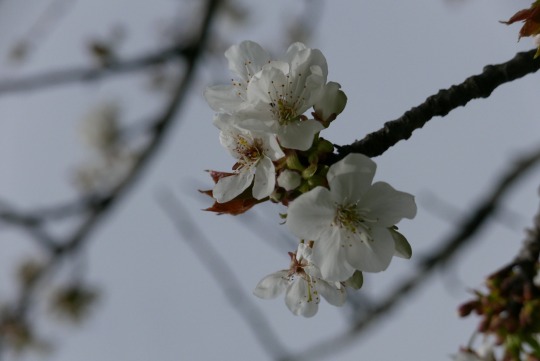


A valentine from Stella di Lemmen
Love is one of the most overused, abused, emphasized, dramatized and misunderstood words in our vocabulary.
Everything is love, everything that appears to our eyes and that "resists" for an elusive instant its fate to disappear: existence.
Nature shows us exactly that, as it overcomes death with its constant transformation.
Because "l'amore" conquers "la morte".
Una valentina da Stella di Lemmen
Amore è una tra le parole più inflazionate, abusate, enfatizzate, drammatizzate e miscomprese del nostro vocabolario.
Tutto è amore, tutto quello che appare ai nostri occhi e che "resiste" per un'inafferrabile istante alla scomparsa: l'esistenza.
Ce lo racconta bene la natura che, con la sua costante trasformazione, vince la morte.
Perché l'amore vince la morte.

2 notes
·
View notes
Text
The tenacious little Japanese machine
We will never tire of remembering how generous nature is, fundamental to our life and our livelihood. Nowadays it becomes more and more urgent, even essential, to try not to damage or weaken it, and to live in harmony with it.
The earth nourishes us, but the consequence is a physiological impoverishment, as part of its nutrients are transferred and transformed in the produce. In order to sustain its productive cycle, it is advisable to give back as much as possible of what it has consumed.
Our precious, small, tenacious wood chipper comes from Japan and allows us to transform the byproduct of pruning on the spot, reducing the dried vines into thin shreds that are perfect for mulching the soil.
This agricultural practice slows down the evaporation of water and therefore maintains soil humidity for longer in the hot months, counteracts the growth of weeds and, through decomposition, returns useful nutrients to the soil. This is how an element of waste and clutter can be immediately transformed and reintegrated into the production cycle.
Another way to use our wood chips, which come not only from the vineyard but also from the pruning of plants and shrubs all across the farm, is to integrate them into the biodynamic pile. This way we obtain an effective soil conditioner and bioactivator...which we will focus on in a future article!
We have chosen the smallest model of this machine (which, however, can still chop branches of 4/5 cm in diameter!) to be able to move it easily to any corner of the farm, overcoming even the most difficult climbs.
Thank you great little Ohashi! We can only be grateful for the effectiveness with which you carry out your task of transforming a waste product, which would otherwise need to be disposed of, into a valuable element that can be reintegrated into the earth to make it healthy, fertile and generous.
La piccola giapponese tenace
Non ci stancheremo mai di ricordare quanto la natura sia generosa, fondamentale per la nostra vita e la nostra sussistenza. Al giorno d’oggi diventa sempre più urgente e imprescindibile cercare di non danneggiarla, di non impoverirla e di vivere quanto più in armonia con essa.
La terra ci alimenta, ma la conseguenza è un suo fisiologico impoverimento, in quanto parte dei suoi nutrienti vengono ceduti e si trasformano nel raccolto. Per sostenere il suo ciclo produttivo è bene restituirle quanto più possibile quello che ha consumato.
La nostra preziosa, piccola, tenace cippatrice viene dal Giappone e ci consente di trasformare seduta stante il risultato della potatura delle viti, riducendo i tralci in un sottile truciolato perfetto per pacciamare il terreno.
Questa pratica agricola frena l’evaporazione dell’acqua e mantiene quindi più a lungo l’umidità del suolo nei mesi caldi, contrasta la crescita delle infestanti e, con la decomposizione, restituisce al suolo utili nutrienti. Ecco come un elemento di scarto e disordine può venire subitamente trasformato e reintegrato nel ciclo produttivo.
Un altro modo per utilizzare il nostro truciolato, proveniente non soltanto dalla vigna ma dalla potatura di piante e arbusti sparse per tutta l'azienda, è di integrarlo nel cumulo biodinamico. Otteniamo così un efficace ammendante e bioattivatore del terreno...del quale vi racconteremo nel dettaglio in futuro!
Noi abbiamo scelto il modello più piccolo di questo macchinario (che però arriva a tritare rami di 4/5 centimetri di diametro!) per poterlo spostare agevolmente in qualunque angolo della campagna, affrontando anche le salite più impervie.
Grazie piccola grande Ohashi! Non possiamo che esserti grati per l’efficacia con la quale svolgi il tuo compito di trasformare un prodotto di scarto, che andrebbe altrimenti smaltito, in un pregevole elemento da reintegrare nella terra, affinché possa continuare ad essere sana, fertile e generosa.


#farm#wine#farming#biodynamicfarming#biodynamicwine#biologico#cinqueterre#biodinamica#biodynamic#organic#Ohashi#wood chipper
0 notes